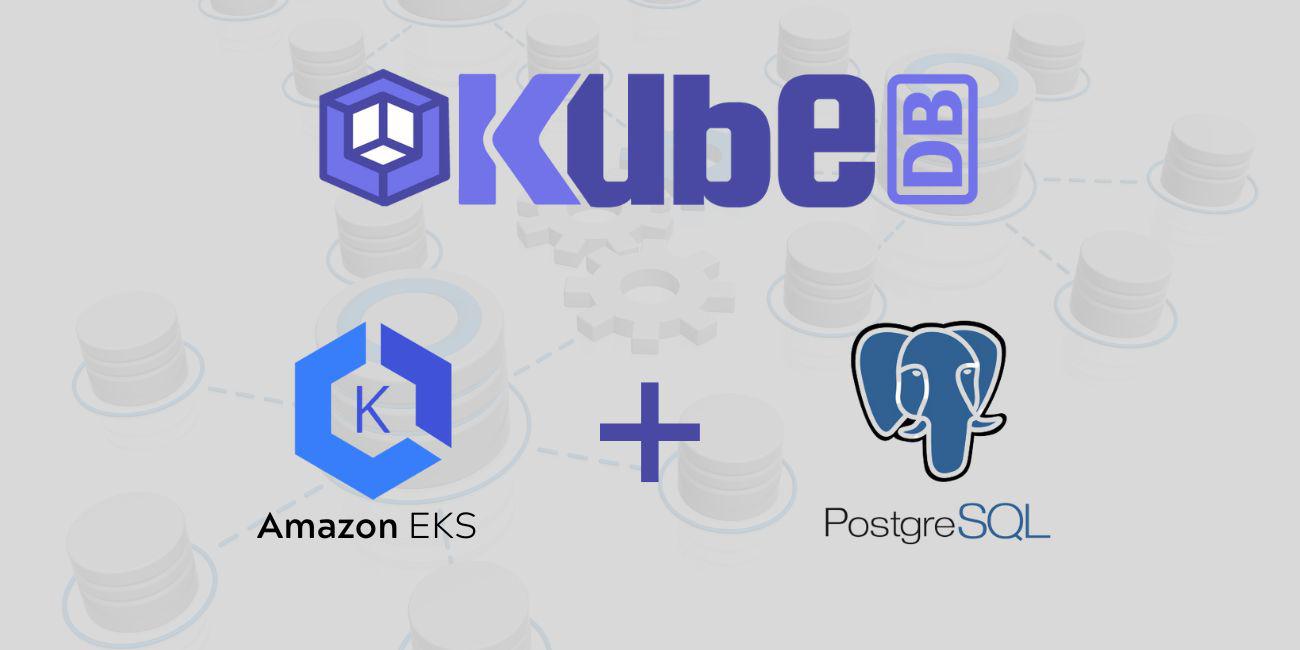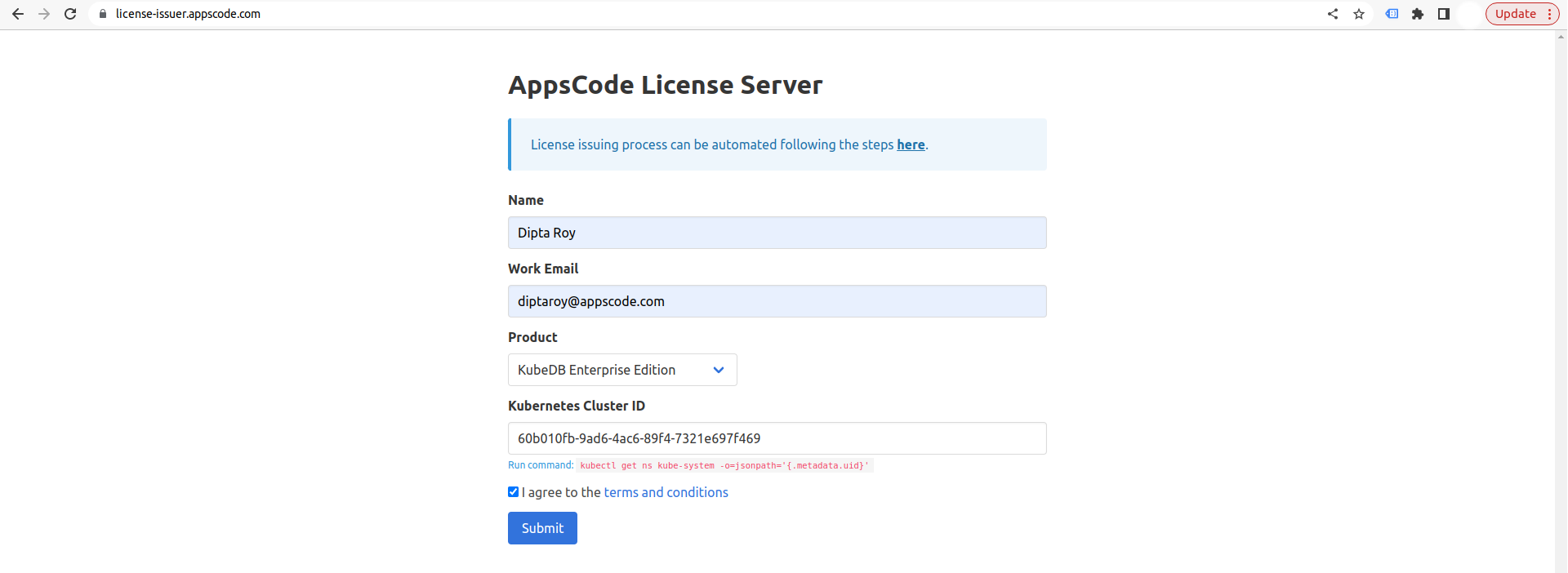
Overview
KubeDB is the Kubernetes Native Database Management Solution which simplifies and automates routine database tasks such as Provisioning, Monitoring, Upgrading, Patching, Scaling, Volume Expansion, Backup, Recovery, Failure detection, and Repair for various popular databases on private and public clouds. The databases that KubeDB supports are PostgreSQL, MySQL, MongoDB, MariaDB, Elasticsearch, Redis, ProxySQL, Percona XtraDB, Memcached and PgBouncer. You can find the guides to all the supported databases in KubeDB . In this tutorial we will be upgrading PostgreSQL Standalone to a High Availability Cluster in Amazon Elastic Kubernetes Service (Amazon EKS). We will cover the following steps:
- Install KubeDB
- Deploy PostgreSQL Standalone
- Read/Write Sample Data
- Horizontal Scaling of PostgreSQL Standalone
Get Cluster ID
We need the cluster ID to get the KubeDB License. To get cluster ID we can run the following command:
$ kubectl get ns kube-system -o jsonpath='{.metadata.uid}'
60b010fb-9ad6-4ac6-89f4-7321e697f469
Get License
Go to Appscode License Server to get the license.txt file. For this tutorial we will use KubeDB Enterprise Edition.

Install KubeDB
We will use helm to install KubeDB. Please install helm here
if it is not already installed.
Now, let’s install KubeDB.
$ helm repo add appscode https://charts.appscode.com/stable/
$ helm repo update
$ helm search repo appscode/kubedb
NAME CHART VERSION APP VERSION DESCRIPTION
appscode/kubedb v2023.02.28 v2023.02.28 KubeDB by AppsCode - Production ready databases...
appscode/kubedb-autoscaler v0.17.0 v0.17.0 KubeDB Autoscaler by AppsCode - Autoscale KubeD...
appscode/kubedb-catalog v2023.02.28 v2023.02.28 KubeDB Catalog by AppsCode - Catalog for databa...
appscode/kubedb-community v0.24.2 v0.24.2 KubeDB Community by AppsCode - Community featur...
appscode/kubedb-crds v2023.02.28 v2023.02.28 KubeDB Custom Resource Definitions
appscode/kubedb-dashboard v0.8.0 v0.8.0 KubeDB Dashboard by AppsCode
appscode/kubedb-enterprise v0.11.2 v0.11.2 KubeDB Enterprise by AppsCode - Enterprise feat...
appscode/kubedb-grafana-dashboards v2023.02.28 v2023.02.28 A Helm chart for kubedb-grafana-dashboards by A...
appscode/kubedb-metrics v2023.02.28 v2023.02.28 KubeDB State Metrics
appscode/kubedb-ops-manager v0.19.0 v0.19.2 KubeDB Ops Manager by AppsCode - Enterprise fea...
appscode/kubedb-opscenter v2023.02.28 v2023.02.28 KubeDB Opscenter by AppsCode
appscode/kubedb-provisioner v0.32.0 v0.32.1 KubeDB Provisioner by AppsCode - Community feat...
appscode/kubedb-schema-manager v0.8.0 v0.8.0 KubeDB Schema Manager by AppsCode
appscode/kubedb-ui v2022.06.14 0.3.26 A Helm chart for Kubernetes
appscode/kubedb-ui-server v2021.12.21 v2021.12.21 A Helm chart for kubedb-ui-server by AppsCode
appscode/kubedb-webhook-server v0.8.0 v0.8.0 KubeDB Webhook Server by AppsCode
# Install KubeDB Enterprise operator chart
$ helm install kubedb appscode/kubedb \
--version v2023.02.28 \
--namespace kubedb --create-namespace \
--set kubedb-provisioner.enabled=true \
--set kubedb-ops-manager.enabled=true \
--set kubedb-autoscaler.enabled=true \
--set kubedb-dashboard.enabled=true \
--set kubedb-schema-manager.enabled=true \
--set-file global.license=/path/to/the/license.txt
Let’s verify the installation:
$ kubectl get pods --all-namespaces -l "app.kubernetes.io/instance=kubedb"
NAMESPACE NAME READY STATUS RESTARTS AGE
kubedb kubedb-kubedb-autoscaler-59645757f8-q7kbl 1/1 Running 0 4m7s
kubedb kubedb-kubedb-dashboard-86b798dc88-ss66q 1/1 Running 0 4m7s
kubedb kubedb-kubedb-ops-manager-6f686d6ccc-94rv2 1/1 Running 0 4m7s
kubedb kubedb-kubedb-provisioner-75cc768444-hs8vn 1/1 Running 0 4m7s
kubedb kubedb-kubedb-schema-manager-87b855b48-ndt68 1/1 Running 0 4m7s
kubedb kubedb-kubedb-webhook-server-855c6cb7c5-g7hmx 1/1 Running 0 4m7s
We can list the CRD Groups that have been registered by the operator by running the following command:
$ kubectl get crd -l app.kubernetes.io/name=kubedb
NAME CREATED AT
elasticsearchautoscalers.autoscaling.kubedb.com 2023-03-16T05:09:19Z
elasticsearchdashboards.dashboard.kubedb.com 2023-03-16T05:09:14Z
elasticsearches.kubedb.com 2023-03-16T05:09:14Z
elasticsearchopsrequests.ops.kubedb.com 2023-03-16T05:10:06Z
elasticsearchversions.catalog.kubedb.com 2023-03-16T05:06:17Z
etcds.kubedb.com 2023-03-16T05:09:24Z
etcdversions.catalog.kubedb.com 2023-03-16T05:06:18Z
kafkas.kubedb.com 2023-03-16T05:10:03Z
kafkaversions.catalog.kubedb.com 2023-03-16T05:06:18Z
mariadbautoscalers.autoscaling.kubedb.com 2023-03-16T05:09:19Z
mariadbdatabases.schema.kubedb.com 2023-03-16T05:09:24Z
mariadbopsrequests.ops.kubedb.com 2023-03-16T05:10:34Z
mariadbs.kubedb.com 2023-03-16T05:09:24Z
mariadbversions.catalog.kubedb.com 2023-03-16T05:06:19Z
memcacheds.kubedb.com 2023-03-16T05:09:32Z
memcachedversions.catalog.kubedb.com 2023-03-16T05:06:19Z
mongodbautoscalers.autoscaling.kubedb.com 2023-03-16T05:09:19Z
mongodbdatabases.schema.kubedb.com 2023-03-16T05:09:17Z
mongodbopsrequests.ops.kubedb.com 2023-03-16T05:10:10Z
mongodbs.kubedb.com 2023-03-16T05:09:19Z
mongodbversions.catalog.kubedb.com 2023-03-16T05:06:20Z
mysqlautoscalers.autoscaling.kubedb.com 2023-03-16T05:09:20Z
mysqldatabases.schema.kubedb.com 2023-03-16T05:09:15Z
mysqlopsrequests.ops.kubedb.com 2023-03-16T05:10:30Z
mysqls.kubedb.com 2023-03-16T05:09:16Z
mysqlversions.catalog.kubedb.com 2023-03-16T05:06:21Z
perconaxtradbautoscalers.autoscaling.kubedb.com 2023-03-16T05:09:20Z
perconaxtradbopsrequests.ops.kubedb.com 2023-03-16T05:12:01Z
perconaxtradbs.kubedb.com 2023-03-16T05:09:54Z
perconaxtradbversions.catalog.kubedb.com 2023-03-16T05:06:21Z
pgbouncers.kubedb.com 2023-03-16T05:09:54Z
pgbouncerversions.catalog.kubedb.com 2023-03-16T05:06:22Z
postgresautoscalers.autoscaling.kubedb.com 2023-03-16T05:09:20Z
postgresdatabases.schema.kubedb.com 2023-03-16T05:09:21Z
postgreses.kubedb.com 2023-03-16T05:09:23Z
postgresopsrequests.ops.kubedb.com 2023-03-16T05:10:52Z
postgresversions.catalog.kubedb.com 2023-03-16T05:06:22Z
proxysqlautoscalers.autoscaling.kubedb.com 2023-03-16T05:09:21Z
proxysqlopsrequests.ops.kubedb.com 2023-03-16T05:10:57Z
proxysqls.kubedb.com 2023-03-16T05:10:01Z
proxysqlversions.catalog.kubedb.com 2023-03-16T05:06:22Z
publishers.postgres.kubedb.com 2023-03-16T05:12:12Z
redisautoscalers.autoscaling.kubedb.com 2023-03-16T05:09:22Z
redises.kubedb.com 2023-03-16T05:10:02Z
redisopsrequests.ops.kubedb.com 2023-03-16T05:10:46Z
redissentinelautoscalers.autoscaling.kubedb.com 2023-03-16T05:09:22Z
redissentinelopsrequests.ops.kubedb.com 2023-03-16T05:12:05Z
redissentinels.kubedb.com 2023-03-16T05:10:02Z
redisversions.catalog.kubedb.com 2023-03-16T05:06:23Z
subscribers.postgres.kubedb.com 2023-03-16T05:12:21Z
Deploy PostgreSQL Standalone
Now, we are going to Deploy PostgreSQL using KubeDB. First, let’s create a Namespace in which we will deploy the database.
$ kubectl create namespace demo
namespace/demo created
Here is the yaml of the PostgreSQL CRO we are going to use:
apiVersion: kubedb.com/v1alpha2
kind: Postgres
metadata:
name: postgres
namespace: demo
spec:
version: "13.2"
replicas: 1
storageType: Durable
storage:
storageClassName: "gp2"
accessModes:
- ReadWriteOnce
resources:
requests:
storage: 512Mi
terminationPolicy: WipeOut
Let’s save this yaml configuration into postgres.yaml
Then create the above PostgreSQL CRO
$ kubectl apply -f postgres.yaml
postgres.kubedb.com/postgres created
In this yaml,
- we can see in the
spec.versionfield specifies the version of PostgreSQL. Here, we are using PostgreSQLversion 13.2. You can list the KubeDB supported versions of PostgreSQL by running$ kubectl get postgresversionscommand. spec.storagespecifies PVC spec that will be dynamically allocated to store data for this database. This storage spec will be passed to the StatefulSet created by KubeDB operator to run database pods. You can specify anystorageclassavailable in your cluster with appropriate resource requests. You can get all the availablestorageclassin your cluster by running$ kubectl get storageclasscommand.- And the
spec.terminationPolicyfield is Wipeout means that the database will be deleted without restrictions. It can also be “Halt”, “Delete” and “DoNotTerminate”. Learn More about these HERE .
Once these are handled correctly and the PostgreSQL object is deployed, you will see that the following objects are created:
$ kubectl get all -n demo
NAME READY STATUS RESTARTS AGE
pod/postgres-0 1/1 Running 0 61s
NAME TYPE CLUSTER-IP EXTERNAL-IP PORT(S) AGE
service/postgres ClusterIP 10.8.5.12 <none> 5432/TCP,2379/TCP 64s
service/postgres-pods ClusterIP None <none> 5432/TCP,2380/TCP,2379/TCP 65s
NAME READY AGE
statefulset.apps/postgres 1/1 67s
NAME TYPE VERSION AGE
appbinding.appcatalog.appscode.com/postgres kubedb.com/postgres 13.2 72s
NAME VERSION STATUS AGE
postgres.kubedb.com/postgres 13.2 Ready 97s
Check the PVC in the demo namespace,
$ kubectl get pvc -n demo
NAME STATUS VOLUME CAPACITY ACCESS MODES STORAGECLASS AGE
data-postgres-0 Bound pvc-61bbfd87-2fc8-44fa-abd8-a10930b7eb4d 1Gi RWO standard 2m
Let’s check if the database is ready to use,
$ kubectl get postgres -n demo postgres
NAME VERSION STATUS AGE
postgres 13.2 Ready 2m
We have successfully deployed PostgreSQL in EKS. Now we can exec into the container to use the database.
Accessing Database Through CLI
To access the database through CLI, we have to get the credentials to access.
KubeDB will create Secret and Service for the database postgres that we have deployed. Let’s check them using the following commands,
$ kubectl get secret -n demo -l=app.kubernetes.io/instance=postgres
NAME TYPE DATA AGE
postgres-auth kubernetes.io/basic-auth 2 4m
$ kubectl get service -n demo -l=app.kubernetes.io/instance=postgres
NAME TYPE CLUSTER-IP EXTERNAL-IP PORT(S) AGE
postgres ClusterIP 10.8.5.12 <none> 5432/TCP,2379/TCP 4m
postgres-pods ClusterIP None <none> 5432/TCP,2380/TCP,2379/TCP 4m
Now, we are going to use postgres-auth to get the credentials.
$ kubectl get secrets -n demo postgres-auth -o jsonpath='{.data.username}' | base64 -d
postgres
$ kubectl get secrets -n demo postgres-auth -o jsonpath='{.data.password}' | base64 -d
5RbcezJjkrK4Aals
Insert Sample Data
In this section, we are going to login into our PostgreSQL database pod and insert some sample data.
$ kubectl exec -it postgres-0 -n demo -c postgres -- bash
bash-5.1$ psql -d "user=postgres password=5RbcezJjkrK4Aals"
psql (13.2)
Type "help" for help.
postgres=# \l
List of databases
Name | Owner | Encoding | Collate | Ctype | Access privileges
---------------+----------+----------+------------+------------+-----------------------
kubedb_system | postgres | UTF8 | en_US.utf8 | en_US.utf8 |
postgres | postgres | UTF8 | en_US.utf8 | en_US.utf8 |
template0 | postgres | UTF8 | en_US.utf8 | en_US.utf8 | =c/postgres +
| | | | | postgres=CTc/postgres
template1 | postgres | UTF8 | en_US.utf8 | en_US.utf8 | =c/postgres +
| | | | | postgres=CTc/postgres
(4 rows)
postgres=# CREATE DATABASE sampledb;
CREATE DATABASE
postgres=# \l
List of databases
Name | Owner | Encoding | Collate | Ctype | Access privileges
---------------+----------+----------+------------+------------+-----------------------
kubedb_system | postgres | UTF8 | en_US.utf8 | en_US.utf8 |
postgres | postgres | UTF8 | en_US.utf8 | en_US.utf8 |
sampledb | postgres | UTF8 | en_US.utf8 | en_US.utf8 |
template0 | postgres | UTF8 | en_US.utf8 | en_US.utf8 | =c/postgres +
| | | | | postgres=CTc/postgres
template1 | postgres | UTF8 | en_US.utf8 | en_US.utf8 | =c/postgres +
| | | | | postgres=CTc/postgres
(5 rows)
postgres=# \c sampledb
You are now connected to database "sampledb" as user "postgres".
sampledb=# CREATE TABLE tab_1 (a int);
CREATE TABLE
sampledb=# INSERT INTO tab_1 values (generate_series(1,1000));
INSERT 0 1000
sampledb=# \q
bash-5.1$ exit
exit
We’ve successfully inserted some sample data to our database. More information about Run & Manage Production-Grade PostgreSQL Database on Kubernetes can be found in PostgreSQL Kubernetes.
Upgrade Standalone to High Availabilty PostgreSQL
Create PostgresOpsRequest
In order to scale up the replicas of the cluster of the database, we have to create a PostgresOpsRequest CR with our desired replicas. Let’s create it using this following yaml,
apiVersion: ops.kubedb.com/v1alpha1
kind: PostgresOpsRequest
metadata:
name: high-availability-cluster
namespace: demo
spec:
type: HorizontalScaling
horizontalScaling:
replicas: 3
streamingMode: Synchronous
standbyMode: Hot
databaseRef:
name: postgres
Let’s save this yaml configuration into high-availability-cluster.yaml
Then create the above PostgreSQL CRO
$ kubectl apply -f high-availability-cluster.yaml
postgresopsrequest.ops.kubedb.com/high-availability-cluster created
spec.databaseRef.namespecifies that we are performing horizontal scaling operation onpostgresdatabase.spec.typespecifies that we are performingHorizontalScalingon our database.spec.horizontalScaling.replicasspecifies the desired replicas after scaling.spec.horizontalScaling.streamingModeis an optional field that specifies the streaming mode (Synchronous/Asynchronous) of the standby replicas.spec.horizontalScaling.standbyModeis an optional field that specifies the standby mode (Warm/Hot) to use for standby replicas. Inhotstandby mode, standby replicas can accept connection and run read-only queries. Inwarmstandby mode, standby replicas can’t accept connection and only used for replication purpose..
Let’s wait for PostgresOpsRequest STATUS to be Successful. Run the following command to watch PostgresOpsRequest CR,
$ watch kubectl get postgresopsrequest -n demo
NAME TYPE STATUS AGE
high-availability-cluster HorizontalScaling Successful 5m
We can see from the above output that the PostgresOpsRequest has succeeded. Now, we are going to verify the number of replicas,
$ kubectl get postgres -n demo postgres -o json | jq '.spec.replicas'
3
From all the above outputs we can see that the replicas of the cluster is now increased to 3. That means we have successfully scaled up the replicas of the PostgreSQL standalone.
Again let’s check the objects in the demo namespace:
$ kubectl get all -n demo
NAME READY STATUS RESTARTS AGE
pod/postgres-0 2/2 Running 0 2m3s
pod/postgres-1 2/2 Running 0 114s
pod/postgres-2 2/2 Running 0 104s
NAME TYPE CLUSTER-IP EXTERNAL-IP PORT(S) AGE
service/postgres ClusterIP 10.100.196.95 <none> 5432/TCP,2379/TCP 2m7s
service/postgres-pods ClusterIP None <none> 5432/TCP,2380/TCP,2379/TCP 2m7s
service/postgres-standby ClusterIP 10.100.39.189 <none> 5432/TCP 2m7s
NAME READY AGE
statefulset.apps/postgres 3/3 2m10s
NAME TYPE VERSION AGE
appbinding.appcatalog.appscode.com/postgres kubedb.com/postgres 13.2 2m19s
NAME VERSION STATUS AGE
postgres.kubedb.com/postgres 13.2 Ready 7m41s
Let’s check if the database is ready to use,
$ kubectl get postgres -n demo postgres
NAME VERSION STATUS AGE
postgres 13.2 Ready 2m
Now, we are going to check one of the newly created replicas to see if it contains the series that we’ve previously created.
$ kubectl exec -it postgres-1 -n demo -c postgres -- bash
bash-5.1$ psql
psql (13.2)
Type "help" for help.
postgres=# \l
List of databases
Name | Owner | Encoding | Collate | Ctype | Access privileges
---------------+----------+----------+------------+------------+-----------------------
kubedb_system | postgres | UTF8 | en_US.utf8 | en_US.utf8 |
postgres | postgres | UTF8 | en_US.utf8 | en_US.utf8 |
sampledb | postgres | UTF8 | en_US.utf8 | en_US.utf8 |
template0 | postgres | UTF8 | en_US.utf8 | en_US.utf8 | =c/postgres +
| | | | | postgres=CTc/postgres
template1 | postgres | UTF8 | en_US.utf8 | en_US.utf8 | =c/postgres +
| | | | | postgres=CTc/postgres
(5 rows)
postgres=# \c sampledb
You are now connected to database "sampledb" as user "postgres".
sampledb=# SELECT COUNT(*) FROM tab_1;
count
-------
1000
(1 row)
sampledb=# \q
bash-5.1$ exit
exit
We can see the series that we’ve created before. So, we’re successfully able to upgrade our PostgreSQL standalone to a high-availability cluster.
We have made an in depth tutorial on Upgrading PostgreSQL Standalone to a High Availability Cluster with KubeDB. You can have a look into the video below:
Support
To speak with us, please leave a message on our website .
To receive product announcements, follow us on Twitter .
To watch tutorials of various Production-Grade Kubernetes Tools Subscribe our YouTube channel.
More about PostgreSQL in Kubernetes
If you have found a bug with KubeDB or want to request for new features, please file an issue .









